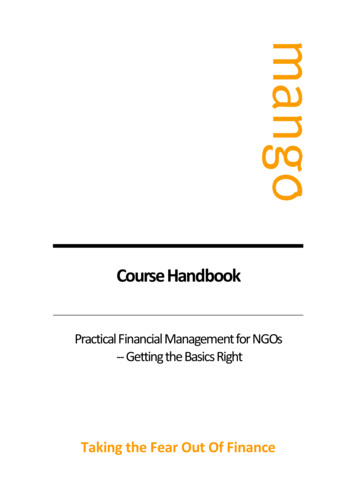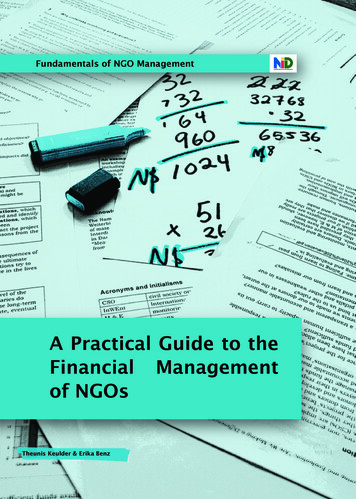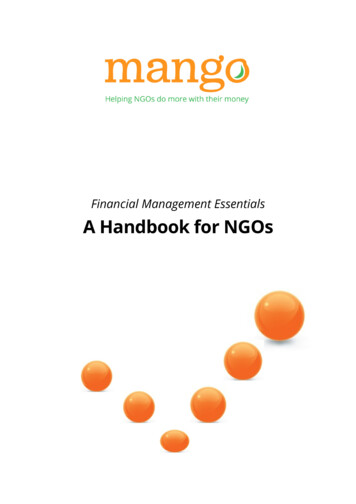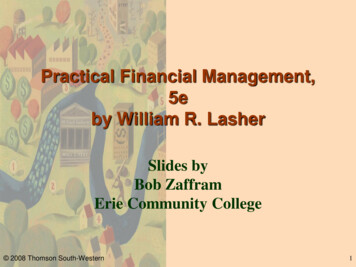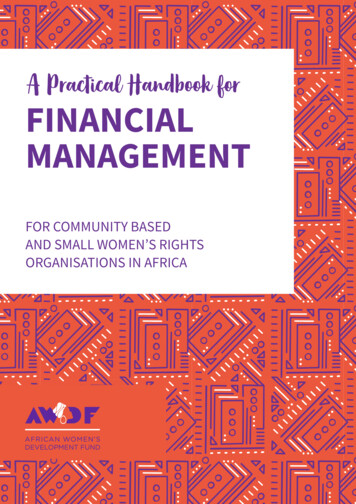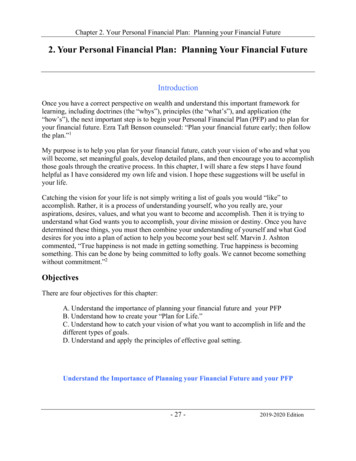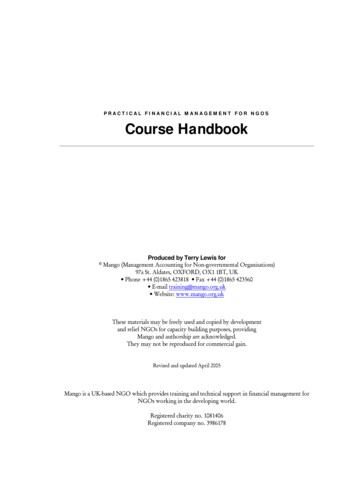
Transcription
PRACTICAL FINANCIAL MANAGEMENT FOR NGOSCourse HandbookProduced by Terry Lewis for Mango (Management Accounting for Non-governmental Organisations)97a St. Aldates, OXFORD, OX1 1BT, UK Phone 44 (0)1865 423818 Fax 44 (0)1865 423560 E-mail training@mango.org.uk Website: www.mango.org.ukThese materials may be freely used and copied by developmentand relief NGOs for capacity building purposes, providingMango and authorship are acknowledged.They may not be reproduced for commercial gain.Revised and updated April 2005Mango is a UK-based NGO which provides training and technical support in financial management forNGOs working in the developing world.Registered charity no. 1081406Registered company no. 3986178
Table of ContentsGlossaryi1. FINANCIAL MANAGEMENT FOR NGOS1Introduction1Why is Financial Management important forNGOs?1What is Financial Management?2What is Financial Control?3Who is Responsible for FinancialManagement?4The Seven Principles of FinancialManagement8The Four Building Blocks of FinancialManagement9The Tools of Financial Management 102. GETTING ORGANISED13Introduction13Systems Design13Financial Accounting vs. ManagementAccounting14The Right System?15The Chart of Accounts15Cost Centres16Cost Structures18Classifying Costs Activity18What is a Finance Manual?19Standard Forms20Work Planning203. PLANNING AND BUDGETSIntroductionThe Financial Planning ProcessWhat is a Budget?Who needs Budgets?Types of BudgetBudget StructuresApproaches to BudgetingSummary of Budget TerminologyThe Budgeting ProcessGood Practice in BudgetingThe Challenge of Core Costs4. UNDERSTANDING ACCOUNTSIntroductionWhy Keep Accounts?Accounting MethodsWhich Accounting Records to Keep212121232324262628293032Supporting Documentation37Bank Book Basics38Petty Cash Book39Full Bookkeeping Systems40What is a Trial Balance?41Financial Statements42The Income and Expenditure Account43The Balance Sheet43What is Depreciation?45A note on Accounting for Shared Costs464. FINANCIAL REPORTSIntroductionWho Needs Financial Reports?The Annual AccountsInterpreting the AccountsManagement ReportingPresenting ReportsUsing the ReportsReporting to Donor AgenciesReporting to Beneficiaries5. SAFEGUARDING YOUR ASSETS4747474949525455585961Introduction61Managing Internal Risk61Delegated Authority62Separation of Duties63Reconciliation64Cash Control66Physical Controls67Dealing with Fraud and Other Irregularities716. MANAGING THE AUDITIntroductionWhat is an Audit?Internal AuditExternal AuditWhat Does the Auditor Need?RECOMMENDED READINGAPPENDCES3333333436 Mango April 200574747474757778
Mango Course HandbookGlossaryAccountA record of monetary transactions, either written into a book designed for thepurpose or entered onto a computer file.Account codeA numbering system used to describe and sort the different types of financialtransactions, grouped by assets, liabilities, income and expenditure.Accounting periodA specified period for recording and reporting financial activity for a given time;usually one year.AccrualsOutstanding expenses for an accounting period which have not yet been paidor invoiced. Opposite of prepayments.Accumulated FundMoney a group may accumulate year by year through not spending all itsincome. Also includes the current estimated value of any fixed assets.Acid TestThe ratio achieved by dividing Current Assets (excl. Stocks) by CurrentLiabilities. It tells us if the organisation has sufficient funds to pay off its debtsimmediately.ApportionmentThe sharing of costs between two or more cost centres in proportion to theestimated benefit received.AssetAny possession or claim on others which is of value to the organisation. Seealso Fixed Assets and Current Assets.Assets RegisterA list of the Fixed Assets of the organisation, usually giving details of value,serial numbers, location, purchase date, etc.AuditThe annual check on the accounts by an independent person (auditor).Audit trailThe ability to follow the course of any reported transaction through anorganisation’s accounting systems.AuthorisationThis is the process of approval over transactions, normally the decision topurchase or commit expenditure. Authorisation by a budget holder is a way ofconfirming that spending is in line with budget and is appropriate.Back donorThe original source of funds, where a grant is channelled through an agency,such as an international NGO, on to an implementing partner. The agencymust report back to the original donor to account for the use of the funds bythe local partner.Balance SheetA summary of the financial position of an organisation at a particular date,showing the assets owned by the organisation and the liabilities or debts owedto others.Bank BookA register which records all transactions passing through a bank account.Also known as a Cash Book or a Cash Analysis Book.Bank reconciliationThe process of agreeing the entries and balance in the Bank Book to the bankstatement entries and balance at a particular date. Acts as a check on thecompleteness and accuracy of the Bank Book entries.BudgetAn amount of money that an organisation plans to raise and spend for a setpurpose over a given period of time.Budget holderThe individual who holds the authority and has the responsibility for managing,a budget for a specified activity, project, programme, department ororganisation.Capital expenditureExpenditure on equipment, property and other fixed assets which will be usedto support activities over more than one accounting period.CashflowThe difference between cash received and cash spent in a period.Chart of AccountsA list of all the accounts codes and cost centre codes that are used in anorganisation’s accounting system. Mango April 2005i
Mango Course HandbookCost CentresA system used in an accounting system to distinguish between differentactivities or projects to define where costs are incurred or income is ‘earned’.Cost centres are closely linked to the concept of budget-holders.CreditorAnyone the organisation owes money to.Current assetsCash and other short-term assets in the process of being turned back intocash – e.g. debtors. They can, in theory, be converted into cash within oneyear.Current liabilitiesShort-term sources of ‘finance’ (e.g. from suppliers, bank overdraft) awaitingpayment in the next 12 months.Current ratioA measure of liquidity obtained by dividing Current Assets by CurrentLiabilities. It tells us if the organisation is able to pay off its debts within 12months.DebtorAny person or other party who owes money to the organisation.DepreciationA proportion of the original cost of a fixed asset which is internally charged asan expense to the organisation in the Income & Expenditure Account.Designated FundsUnrestricted funds which have been accumulated over time and earmarked fora particular purpose by the Trustees.Direct costA cost which can be specifically allocated to an activity, department or project.Donation in kindWhere a grant or contribution to a project is made in the form of goods orservices, rather than a cash grant or donation.Double EntryBookkeepingThe method of recording financial transactions whereby every item is enteredas a debit in one account and a corresponding credit in another.Exception ReportA short narrative report which highlights significant variances and/or areas forconcern to accompany the management accounts.Financial accountingRecording, classifying and sorting historical financial data, resulting infinancial statements for those external to the organisation.Fixed assetsItems (such as equipment, vehicles or buildings) that are owned by anorganisation which retain a significant part of their monetary value for morethan one year. Also known as Tangible Assets.Fund AccountingUsed to identify spending according to the different projects or purpose forwhich the funds were granted.General fundsUnrestricted funds which have not been earmarked and which may be usedgenerally to further the organisation’s objectives. Often referred to asReserves.ImprestA type of cash float, set at an agreed level, which is replenished by the exactamount spent since it was last reimbursed, to bring it back to its original level.Income &Expenditure AccountSummarises income and expenditure transactions for the accounting period,adjusting for transactions that are not yet complete or took place in a differentaccounting period.Indirect costA cost which cannot be specifically allocated to an activity, department orproject but which is more general in nature. Also referred to as overheads.Journal entryAn entry in the books of account which covers a non-monetary transaction –e.g. for recording a donation in kind or an adjustment for correcting a postingerror.LiabilitiesAmounts owed by the organisation to others, including grants received inadvance, loans, accruals and outstanding invoices.LiquidityThe level of cash and assets readily convertible to cash compared to thedemands on the available cash., e.g. to pay bills.Liquidity ratioA measure of liquidity obtained by dividing debtors, cash and short-terminvestments by current liabilities.ii Mango April 2005
Mango Course HandbookManagementaccountingThe provision of financial information to management for the purposes ofplanning, decision-making, and monitoring and controlling performance.Net book valueThe cost of an asset less its accumulated depreciation to date.Net Current assetsFunds available for conducting day-to-day operations of the organisation.Usually defined as current assets less current liabilities. Also known asworking capital.Nominal AccountA ‘page’ in the Nominal Ledger for every type of income or expense, bankaccount, asset or liability likely to occur in an organisation. A complete listappears in the Chart of Accounts.Nominal LedgerConsists of a ‘page’ for every Nominal Account and records of the financialimplications of the organisation’s transactions.OrganogramOrganisation chart showing the management and departmental structure ofthe organisationPetty Cash bookThe day-to-day listing of petty cash paid out.PrepaymentsAmounts paid in advance – e.g. annual insurance premium. Opposite ofaccruals.Receipts & PaymentsaccountA summary of the cash book for the period with opening and closing balances.ReconciliationChecking mechanism which verifies the integrity of different parts of anaccounting system. Especially balancing the Bank Book to the bankstatement.ReservesFunds set aside from surpluses produced in previous years.Restricted fundsIncome funds which have conditions attached to how used, usually with arequirement to report back to the donor.SignatoriesPeople who are authorised to sign cheques on behalf of the organisation.Trial balanceThe list of debit and credit balances on individual nominal accounts from whichan income and expenditure statement is prepared.Unrestricted fundsFunds held for the general purposes of the organisation, for spending withinthe stated objectives.VarianceThe difference between the budget and the actual amount of income orexpenditure.VirementThe ability to transfer from one budget heading to another.Working capitalSee net current assetsYear-endThe cut-off point for the annual financial accounting period.Zero-base budgetingA method of preparing budgets which advocates calculating estimates fromscratch, by considering each cost area afresh. Mango April 2005iii
Mango Course Handbookiv Mango April 2005
Mango Course Handbook1ChapterFinancial Management forNGOsAn Introduction to Financial Management and Control in the NGO SectorIntroductionThis chapter:Explains why financial management is important for NGOs.Clarifies what financial management and financial control involves.Describes the underlying principles of financial management.Explains roles and responsibilities for financial management.Outlines the building blocks and tools of financial management.Why is Financial Management important for NGOs?In many NGOs financial management is given a low priority. This is often characterisedby poor financial planning and monitoring systems.But NGOs operate in a rapidly changing and competitive world. If their organisations areto survive in this challenging environment, managers need to develop the necessaryunderstanding and confidence to make full use of financial management tools.Good practice in financial management will:help managers to make effective and efficient use of resources to achieveobjectives and fulfil commitments to stakeholdershelp NGOs to be more accountable to donors and other stakeholdersgain the respect and confidence of funding agencies, partners and beneficiariesgive the NGO the advantage in competition for increasingly scarce resourceshelp NGOs prepare themselves for long-term financial sustainability.Some very persuasive reasons for getting it right! Mango April 20051
Mango Course HandbookWhat is Financial Management?Financial management is not just about keeping accounting records. It is an important partof programme management and must not be seen as a separate activity left to finance staff.Financial management entails planning, organising, controlling and monitoring the financialresources of an organisation to achieve objectives.Financial management to an NGO is rather like maintenance is to a vehicle. If we don’tput in good quality fuel and oil and give it a regular service, the functioning of the vehiclesuffers and it will not run efficiently. If neglected, the vehicle will eventually break downand fail to reach its intended destination.In practice, financial management is about taking action to look after the financial health ofan organisation, and not leaving things to chance. This will involve: Managing scarce resourcesNGOs operate in a competitive environment where donor funds are increasingly scarce.We must therefore make sure that donated funds and resources are used properly, and tothe best effect, to achieve the organisation’s mission and objectives. Managing riskAll organisations face internal and external risks which can
Course Handbook. Produced by Terry Lewis for. Mango (Management Accounting for Non-governmental Organisations) 97a St. Aldates, OXFORD, OX1 1BT, UK Phone 44 (0)1865 423818 Fax 44 (0)1865 423560 E-mail training@mango.org.uk Website: www.mango.org.uk. These materials may be freely used and copied by development and relief NGOs for .File Size: 1MBPage Count: 85
